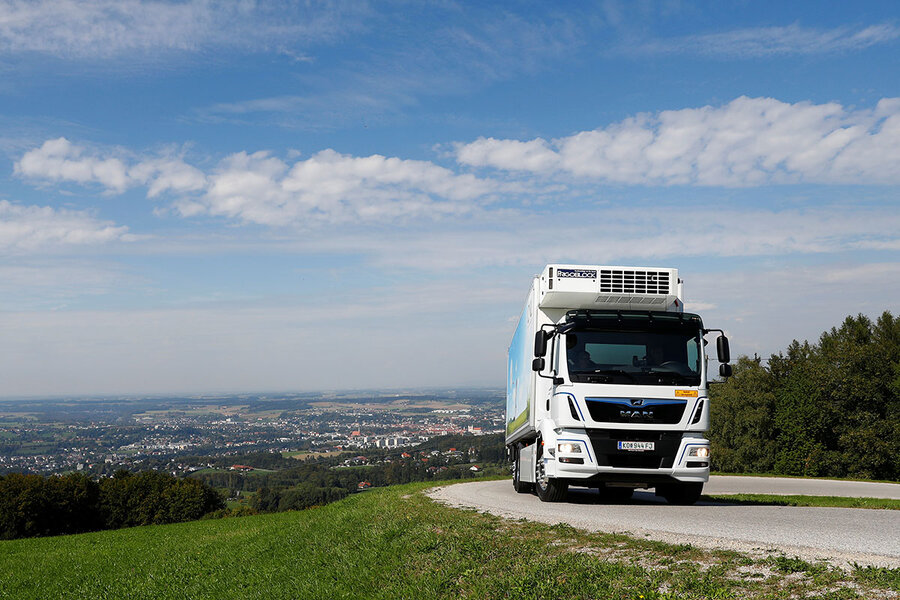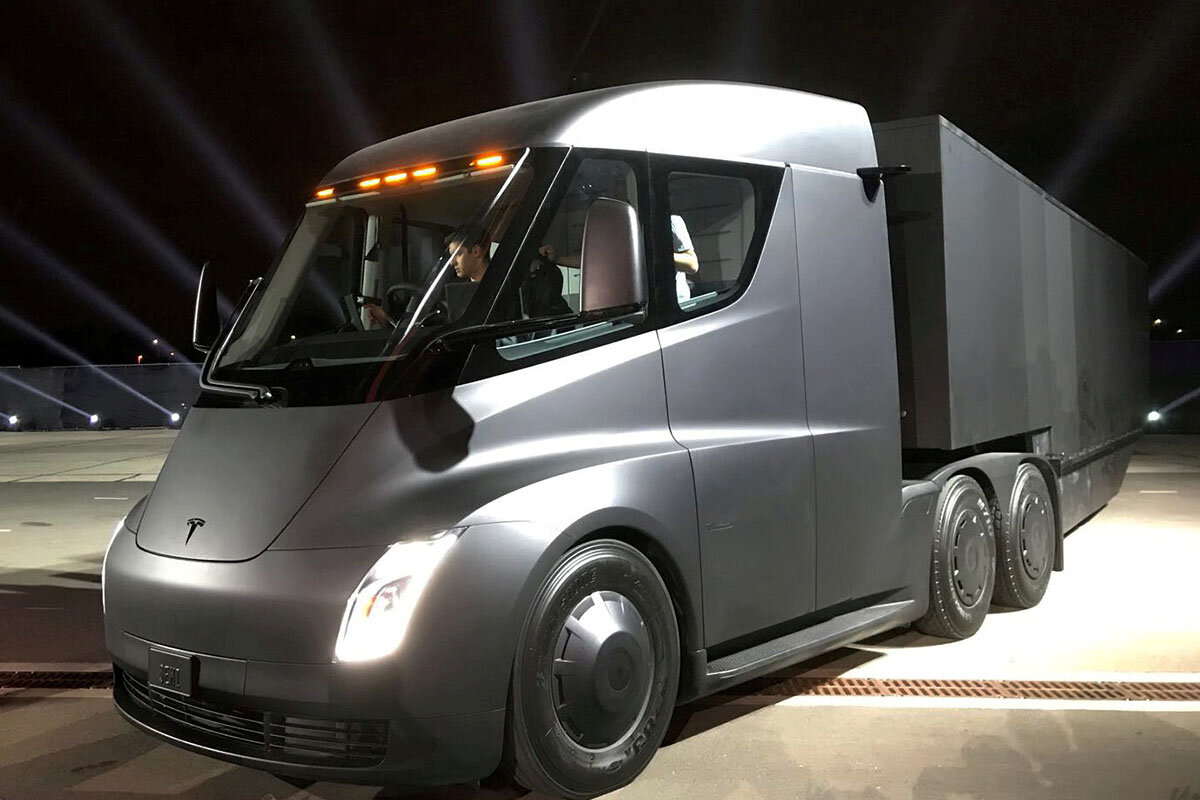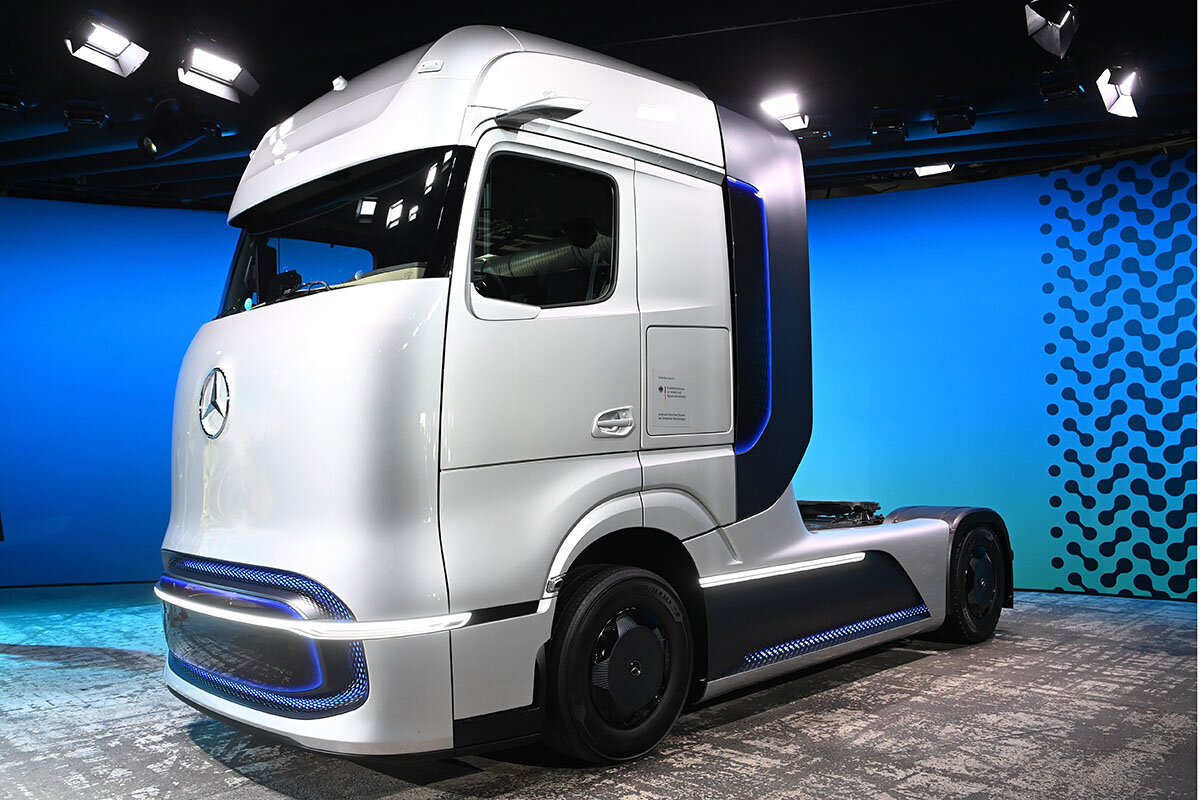Can freight trucks pull their weight in lowering carbon emissions?
Loading...
“It blows my mind. I hope it’ll blow yours.”
So said Elon Musk, CEO of Tesla, after leaping out of his company’s new offering onto a stage, greeted by adoring applause from a sea of fans, back in 2017.
The vehicle in question – while electric, of course – was a heavy truck, and Mr. Musk extolled it as supposedly superior to the diesel-powered 18-wheelers currently crisscrossing our continents. Today the first Tesla Semis are close to rolling off the production line. Competitors from firms including Volvo and Scania are already on the roads.
Why We Wrote This
Progress in battery technology is opening the way for even long-haul heavy trucks to go electric. A big need now is for amped-up charging stations to help them roll.
Given the loads of freight they pull and the distances they cover, you might think semitrailer trucks would be a far-off milestone in a global transition toward electrified transport. Yet advancing technology is fast putting the idea of decarbonizing overland freight traffic within reach. And the environmental benefits are compelling.
Road freight transport accounts for 7% of global energy-related carbon dioxide emissions, double that of the aviation sector, as well as some 20% of the world’s oil demand. With that in view, governments are increasingly setting targets for shifting commercial trucking – from buses and small delivery trucks up to 18-wheelers – away from fossil fuels. A band of green-minded U.S. states, for example, is aiming for 30% of commercial-truck sales be for zero-emissions vehicles by 2030.
The big challenge ahead is that an electric revolution in freight hauling will require some big investments in vehicle-charging stations – infrastructure that is now in its infancy, transportation experts say.
“It absolutely will require upgrades” to electric-utility systems, says Jessie Lund, a senior associate in the carbon-free mobility program at RMI, a nonprofit that promotes a clean-energy economy. But “we’re not talking about every truck in the continent electrifying tomorrow, so I have a little faith that [U.S.] utilities will be able to plan for it and make the necessary upgrades.”
What’s clear, though, is that this next wave of electric transportation is different from the tide of passenger electric vehicles (EVs) currently being brought to market.
“The narrative that’s been growing in the past couple of years to deal with climate change is basically to electrify everything, which I think is great,” says Olle Olsson, senior research fellow at the Stockholm Environment Institute, and co-author of a recent study on the feasibility of heavy battery-electric trucks. “But it also puts massive demands on the power infrastructure, and there are still some challenges there as to how to build it.”
Are power grids ready?
The heaviest weigh upwards of 15 tons, compared with one or two tons for a typical car. This means the batteries are far more power-hungry, which, in turn, means the chargers either have to be plugged in for many more hours – or they need to provide higher levels of electricity.
For a good many commercial vehicles, one overnight charge may be enough for the next day’s work. But power grids are already facing new demands in transitioning to renewable energy, as well as the burgeoning fleet of passenger EVs. Some experts worry that grids may require substantial redevelopment to cope. Others don’t see the hurdles as daunting.
“I think it’s fewer upgrades than a lot of people think. I think even [the utility companies] have been surprised at how a lot of it is capable of supporting these vehicles today,” says Ms. Lund, who specializes in emissions reductions from heavy-duty transport.
Indeed, the shift to electric trucks is still in its nascent stages. Volvo Trucks, for instance, has delivered just a single specimen of its FL Electric to date in the whole of the United Kingdom, and expects to sell a total of around 10 this year in the U.K./Ireland market, a company spokesman says by email.
Yet confidence in an electric future abounds, with truck-makers such as Volvo, DAF, Scania, Daimler, and Kenworth all rolling out EV models. Volvo has even announced a target of 50% of its European truck sales being EV editions by 2030.
A road paved by technology
This confidence has to do, in part, with the technological advances of recent years. Ms. Lund says lithium-ion batteries – the dominant kind in EVs – have fallen in cost by around 90% in the past decade.
In lockstep with falling costs, the energy density achievable in these batteries has gone in the opposite direction, seeing constant improvements. For trucks, this is vital, as higher energy density means smaller batteries – and that means less weight and more space for goods.
Then there is the charging side. Fast chargers for passenger EVs generally range from 50-150 kilowatts, or even as high as 350kW. These levels can be just fine to charge heavy trucks if they’re able to sit still for many hours. When long-haul trucks need to power up mid-journey, far more powerful chargers are going to be needed.
“First of all, it’s technically possible,” says Mark Duvall, director of electrification and customer solutions at the Electric Power Research Institute (EPRI.) “Very high-powered charging does present a series of challenges, and they’ll be overcome.”
With chargers in development capable of delivering as much as 3 megawatts (3,000 kW) there are groups already busy at work seeking to surmount some of the associated difficulties. CharIN, a Berlin-based association of more than 200 organizations across the globe involved in e-mobility, set up its Megawatt Charging System initiative in 2018, seeking standards for charging heavy-duty vehicles.
Meanwhile in the U.S., a West Coast Clean Transit Corridor Initiative among electric utilities is envisioning how these chargers could be distributed at 50-mile intervals along routes in California, Oregon, and Washington state. California is home to additional similar initiatives.
California’s ambitious goal
California is a hotbed of activity because of its stringent regulations: Last year the California Air Resources Board implemented a directive requiring more than 55% of truck sales to be of zero-emissions models by 2035, rising to 100% a decade after that.
“Policies have been big drivers for everything we’ve accomplished to date,” says Mr. Duvall of EPRI, who has been working on EVs for almost three decades. “Given that most new technologies don’t start off being cost-competitive, or cost-superior to the incumbent technology, it’s those policy incentives that accelerate the existing market.”
A whole other option for zero-emissions freight hauling – power from hydrogen fuel cells – has gotten a boost from both Toyota and the startup Nikola. Toyota rolled out its prototype heavy-duty truck in December to haul cargo around the ports of Los Angeles and Long Beach.
Mr. Duvall says he’s always supported exploring various technologies rather than eliminating options early in the game. But, with hydrogen requiring its own infrastructure, he adds that “it’s very hard to dethrone an existing technology … . So, 10 years ago, or 15 years ago, before EVs were commercialized, before hydrogen vehicles were commercialized, you could argue that neither technology had that advantage; now, they’re in very different places.”
Editor's note: A sentence in this article was updated after publication so that one group is mentioned by its preferred name, RMI.







